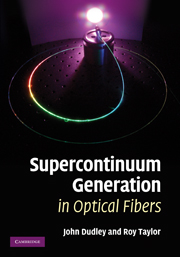Book contents
- Frontmatter
- Contents
- List of contributors
- Preface
- 1 Introduction and history
- 2 Supercontinuum generation in microstructure fibers – a historical note
- 3 Nonlinear fibre optics overview
- 4 Fibre supercontinuum generation overview
- 5 Silica fibres for supercontinuum generation
- 6 Supercontinuum generation and nonlinearity in soft glass fibres
- 7 Increasing the blue-shift of a picosecond pumped supercontinuum
- 8 Continuous wave supercontinuum generation
- 9 Theory of supercontinuum and interaction of solitons with dispersive waves
- 10 Interaction of four-wave mixing and stimulated Raman scattering in optical fibers
- 11 Nonlinear optics in emerging waveguides: revised fundamentals and implications
- 12 Supercontinuum generation in dispersion-varying fibers
- 13 Supercontinuum generation in chalcogenide glass waveguides
- 14 Supercontinuum generation for carrier-envelope phase stabilization of mode-locked lasers
- 15 Biophotonics applications of supercontinuum generation
- 16 Fiber sources of tailored supercontinuum in nonlinear microspectroscopy and imaging
- Index
10 - Interaction of four-wave mixing and stimulated Raman scattering in optical fibers
Published online by Cambridge University Press: 06 July 2010
- Frontmatter
- Contents
- List of contributors
- Preface
- 1 Introduction and history
- 2 Supercontinuum generation in microstructure fibers – a historical note
- 3 Nonlinear fibre optics overview
- 4 Fibre supercontinuum generation overview
- 5 Silica fibres for supercontinuum generation
- 6 Supercontinuum generation and nonlinearity in soft glass fibres
- 7 Increasing the blue-shift of a picosecond pumped supercontinuum
- 8 Continuous wave supercontinuum generation
- 9 Theory of supercontinuum and interaction of solitons with dispersive waves
- 10 Interaction of four-wave mixing and stimulated Raman scattering in optical fibers
- 11 Nonlinear optics in emerging waveguides: revised fundamentals and implications
- 12 Supercontinuum generation in dispersion-varying fibers
- 13 Supercontinuum generation in chalcogenide glass waveguides
- 14 Supercontinuum generation for carrier-envelope phase stabilization of mode-locked lasers
- 15 Biophotonics applications of supercontinuum generation
- 16 Fiber sources of tailored supercontinuum in nonlinear microspectroscopy and imaging
- Index
Summary
Introduction
Parametric four-wave mixing (FWM) and stimulated Raman scattering (SRS) are two fundamental processes of third-order nonlinear optical materials, and silica optical fibers in particular (Agrawal, 2006). As will be clear from many of the preceding chapters in this book, they also play a central role in supercontinuum generation. On the one hand, FWM involves the elastic interaction between two pump photons as well as a Stokes and an anti-Stokes photon symmetrically located around the pump frequency (Stolen, 1975; Stolen and Bjorkholm, 1982). It is of tremendous interest for large bandwidth optical amplification (Hansryd et al., 2002), including ultra-low-noise phase-sensitive amplification (McKinstrie and Radic, 2004; Oo-Kaw et al., 2008), but also for parametric oscillators (Coen and Haelterman, 2001; Sharping, 2008), wavelength converters (Islam and Boyraz, 2002) including noise-free schemes (Gnauck et al., 2006; Méchin et al., 2006) or optical signal processing in general (Salem et al., 2008). Its efficiency critically depends on a phase-matching relation, which is related to momentum conservation. On the other hand, SRS is characterized by the stimulated inelastic conversion of photons from an intense optical pump wave into lower frequency Stokes photons through the resonant excitation of a vibration in the transmission medium (i.e., optical phonons) (Bloembergen, 1967; Stolen et al., 1972). Here phase-matching is automatically satisfied. The SRS gain, in contrast to the FWM gain, exhibits an asymmetric profile (Stolen and Ippen, 1973): only the down-shifted Stokes waves are amplified while the up-shifted anti-Stokes waves are exponentially absorbed.
- Type
- Chapter
- Information
- Supercontinuum Generation in Optical Fibers , pp. 199 - 225Publisher: Cambridge University PressPrint publication year: 2010

